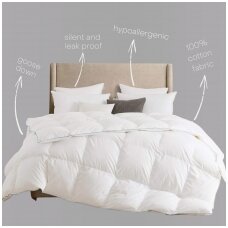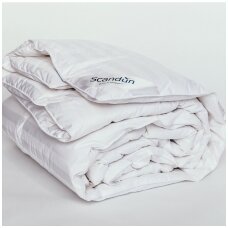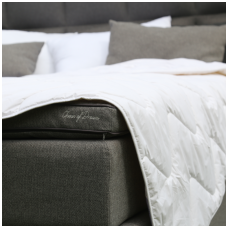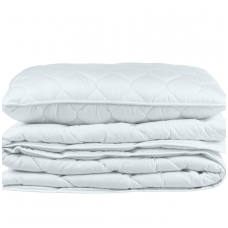WHICH BLANKET TO CHOOSE?
-

Which blanket to choose?
The blanket is very important for the quality of our sleep and rest. We want cozy warmth in winter, and comfortable, cool blankets in summer. The blanket must meet your individual sleeping needs and not cause allergies. So how to choose the most suitable blanket from different types of fillings? Will the blanket cause allergies?
What are the fillings for blankets?The most popular fillers are natural cashmere, silk, wool, natural down and polyester. Natural fillers are good heat insulators, allow air to circulate and help maintain the correct body temperature. People with allergies often choose synthetic fillers.
Blankets filled with feathers and down of wading birds have moisture-absorbing and heat-retaining properties. When sleeping, the microclimate becomes ideal, because down blankets completely remove excess moisture from the human body. Thanks to these properties, the body's optimal temperature is maintained during sleep, even when the ambient temperature varies. The quality of down-and-feather products varies accordingly with the ratio of down and feathers in it - the higher the ratio of down, the higher the quality of the product.
Blankets with natural silk are characterized by exceptional luxury. It is a great choice for those who value comfort and naturalness. The blanket is filled with mulberry silk fiber, which has natural antibacterial properties. It is resistant to dust mites. Blankets with silk are thin enough, but have excellent thermoregulatory properties - you won't be hot in the summer with it, and cold in the winter. The silk-filled blanket allows the skin to breathe and ensures excellent air circulation. In addition, such a blanket stands out for its lightness, so it is perfect for those who appreciate the feeling of lightness.
Blankets with sheep's wool create a healthy, natural and safe sleeping environment. Washable sheep's wool is hygienic - it naturally prevents the growth of bacteria, perfectly absorbs moisture and evaporates it, and maintains an optimal body temperature during sleep. Blankets filled with sheep's wool are suitable for use in all seasons. Wool blankets can also be washed in a washing machine, which further ensures a clean and hygienic sleeping environment.
Antiallergic, hollow siliconized polyester fiber can be used for filling. Such a blanket is fluffy and soft and breathes well. A blanket with polyester filling can be used all year round. Such blankets are easy to care for, they can be washed in a normal washing machine at a temperature of 60 degrees. This temperature is sufficient to destroy various bacteria and dust mites, thus creating a safe and clean sleeping environment.Microfiber ball blanket is fluffier and softer than hollow siliconized polyester fiber, resulting in better heat retention and less sweating. Such blankets are perfect for people with allergies. Artificial fiber has anti-allergic properties because it breaks down into micro particles less than natural materials. These blankets retain heat and absorb moisture well. The blanket with microfiber balls is very light and fluffy, so it feels like sleeping under a down comforter.
Blanket top fabric. Don't forget to pay attention to the duvet cover as well. When choosing a winter blanket, it is worth choosing a multilayer, durable and heat-retaining cover. The summer blanket should be made of a natural fabric that allows the skin to breathe and absorbs moisture well - cotton or perkel.
Can a blanket cause allergies?
The blanket can cause allergies in certain groups of people who are sensitive to certain allergens. Allergies are usually caused by the filling of the duvet, which can provide an ideal breeding ground for allergens and dust mites.
Synthetic duvet fillings are often hypoallergenic and designed for people who are sensitive to natural fibers or feathers. Down blankets are also suitable for people with allergies, if they are made of high quality and properly maintained. In order for a down blanket to be hypoallergenic, its filling must consist mainly of natural down. And these blankets should be washed at a temperature of 60 degrees to ensure hygiene and sleeping comfort. When changing the bedding, it is recommended to air out the down blankets outside for a few hours and do not forget to hang them up.What are the benefits of anti-stress blankets?
Anti-stress blankets, often referred to as "heavy" blankets, are designed for people who engage in greater physical and mental activity and those who are constantly under stress and tension. Anti-stress blankets have thermal conductivity and antistatic properties, improve blood circulation, perfectly absorb moisture, and relieve fatigue.
These types of blankets can be filled with microfiber or filled with small stone or metal balls that give some additional weight to the surface of the blanket. This weight can help you fall into a more restful and deep sleep by reducing nighttime tossing and turning and insomnia. -



